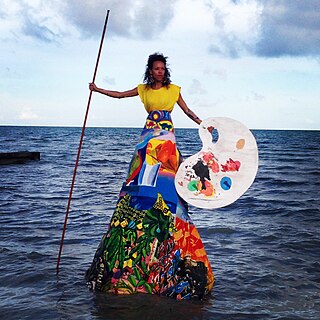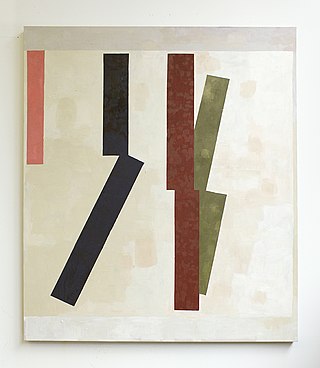Related Research Articles

Art in General was a non-profit contemporary art exhibition space known for its vibrant and ground-breaking projects as a formidable and longstanding New York City alternative space, focused on giving meaningful resources and opportunities to artists early on in their careers. Founded in 1981 by artists Martin Weinstein and Teresa Liszka and originally located in the General Hardware building in New York City — hence the organization's name, Art in General — the institution produced and presented distinctive programs and exhibitions featuring new work by local and international artists.

An artist-run space or artist-run centre (Canada) is a gallery or other facility operated or directed by artists, frequently circumventing the structures of public art centers, museums, or commercial galleries and allowing for a more experimental program. An artist-run initiative (ARI) is any project run by artists, including sound or visual artists, to present their and others' projects. They might approximate a traditional art gallery space in appearance or function, or they may take a markedly different approach, limited only by the artist's understanding of the term. "Artist-run initiatives" is an umbrella name for many types of artist-generated activity.
Hrag Vartanian (born 1973 or 1974) is an Armenian-American arts writer, art critic, and art curator. He is the editor-in-chief and co-founder of the arts online magazine, Hyperallergic.

The Brooklyn Rail is a publication and platform for the arts, culture, humanities, and politics. The Rail is based in Brooklyn, New York. It features in-depth critical essays, fiction, poetry, as well as interviews with artists, critics, and curators, and reviews of art, music, dance, film, books, and theater.
Phong H. Bui is an artist, writer, independent curator, and Co-Founder and Artistic Director of The Brooklyn Rail, a free monthly arts, culture, and politics journal. Bui was named one of the "100 Most Influential People in Brooklyn Culture" by Brooklyn Magazine in 2014. In 2015, The New York Observer called him a "ringmaster" of the "Kings County art world." Bui was the recipient of the 2021 American Academy of Arts and Letters Award for Distinguished Service to the Arts. He lives in Greenpoint, Brooklyn.
Don Voisine is an American abstract painter living in the Williamsburg neighborhood of Brooklyn, New York, USA. In the fall of 2016, "X/V," a 15 year survey of his work, was organized by the Center for Maine Contemporary Art, Rockland, ME. In 1997 he was elected a member of American Abstract Artists and became President of the group in 2004. Voisine was elected to the National Academy in 2010. His work is included in the public collections of the Corcoran Gallery of Art, Washington, DC; Cincinnati Art Museum,Cincinnati, OH; Peabody Essex Museum, Salem MA; the Portland Museum of Art, Portland, ME; the Missoula Art Museum, Missoula, MT and the National Academy, New York, NY.
Vincent Como is a Brooklyn-based visual artist. His work is rooted in Minimalism, Conceptual Art, and Color Field Painting with a specific focus toward Black. Como has referenced the influence of Ad Reinhardt and Kasimir Malevich, as well as movements such as the Italian Arte Povera movement from the 1960s.
Carrie Moyer is an American painter and writer living in Brooklyn, New York. Moyer's paintings and public art projects have been exhibited both in the US and Europe since the early 1990s.

Hansel and Gretel Picture Garden Pocket Utopia was a contemporary art enterprise in New York City. The Hansel and Gretel Picture Garden merged with Pocket Utopia to become one gallery, Hansel and Gretel Picture Garden Pocket Utopia.
Stephanie Buhmann is a German art critic, art historian, and curator. Born and raised in Hamburg, Germany, she lives in New York City and Lübeck, Germany. Her book series "Studio Conversations" focuses on contemporary female artists from different cities. Each book is in a different city. The concept for the "Studio Conversations" project goes back to 2012 when Buhamann became increasingly disenchanted with the media’s fixation the soaring art market. Buhmann states, "I wanted to counterbalance that trend while supporting my community by creating a permanent record of something private and simple: conversations with artists in their studios about the works on their walls."
Gabriele Evertz is an American painter, curator and professor who is applying the history and theory of color in her work. She is known for abstract color painting and Geometric abstraction.

Paula Wilson is an African American "mixed media" artist creating works examining women's identities through a lens of cultural history. She uses sculpture, collage, painting, installation, and printmaking methods such as silkscreen, lithography, and woodblock. In 2007 Wilson moved from Brooklyn, New York, to Carrizozo, New Mexico, where she currently lives and works with her woodworking partner Mike Lagg.
Roberta Allen is a conceptual artist and fiction writer. Her interest in language is the bridge that connects these separate pursuits. As a conceptual artist who combines images and text, she explores how language changes or informs our perception of images. Her works included drawings, artist books, photo/text works, installations, digital prints, and sculpture. Her works in the early 1970s were inspired by Kierkegaard’s belief that our deepest experiences occur in the form of contradictions and wherever there is contradiction humor is present. Through the 1970s, she exhibited alongside Sol LeWitt, Robert Ryman and Carl Andre, among others, at John Weber Gallery in New York. In her writing, which includes, among other books, three micro and short story collections, a novel, a novella and a travel memoir, Allen questions the way we perceive the world and the self. Truths are relative and may change in a flash. The way our minds work and specifically the act of relating is her main subject. She presents disturbing views of the human scene which are often relieved by humor.
Douglas Melini is a New York City and New Jersey based American painter and a CalArts alumnus.
Rindon Johnson is an American artist and writer. Johnson has exhibited and performed widely at exhibitions in New York, Berlin, Los Angeles, San Francisco, and Seattle. Johnson's multidisciplinary art practice blurs the line between photography, sculpture, and performance using various materials such as leather, light, Vaseline, video, photography and wood to explore aspects of lived space, memory, and history. Johnson is a published author and co-runs the online poetry website, Imperial Matters, with Sophia Le Fraga. Johnson lives and works in Brooklyn, New York and Berlin, Germany.
Tomashi Jackson is an American multimedia artist working across painting, video, textiles and sculpture. Jackson was born in Houston, Texas, raised in Los Angeles, and currently lives and works in New York, NY and Cambridge, MA. Jackson was named a 2019 Whitney Biennial participating artist. Jackson also serves on the faculty for sculpture at Rhode Island School of Design. Her work is included in the collection of MOCA Los Angeles. In 2004, a 20-foot-high by 80-foot-long mural by Jackson entitled Evolution of a Community was unveiled in the Los Angeles neighborhood of West Adams.

Rachel Owens is an American artist. She is best known for her multi-media sculptures and installations, which often incorporate a social component. Many of her works are made from crushed glass. She lives and works in New York, NY, and is an assistant professor of art and design at Purchase College, SUNY.
Kenny Rivero is a Dominican-American visual artist who makes paintings, drawings, and sculptures that explore the complexity of identity through narrative images, collage and assemblage, language, and symbolism. Rivero is currently a Lecturer in Painting and Printmaking at the Yale School of Art and a Visiting Artist at The Cooper Union.
Rose Nolan is an Australian visual artist based in Melbourne with work held in the collection of the Museum of Contemporary Art Australia. She makes work in a variety of material forms: books, small sculptures, photographs, posters, paintings, banners, multiples and large-scale installations. A reduced palette of red and white is characteristic of her work. She uses raw and inexpensive materials, such as hessian and cardboard; with the work displaying an unmistakable sense of personal labour through its handmade aesthetic.

Sharon Butler is an American artist and arts writer. She is known for teasing out ideas about contemporary abstraction in her art and writing, particularly a style she called "new casualism" in a 2011 essay. Butler uses process as metaphor and has said in artist's talks that she is keenly interested in creating paintings as documentation of her life. In a 2014 review in the Washington Post, art critic Michael Sullivan wrote that Butler "creates sketchy, thinly painted washes that hover between representation and abstraction.Though boasting such mechanistic titles as 'Tower Vents' and 'Turbine Study,' Butler’s dreamlike renderings, which use tape to only suggest the roughest outlines of architectural forms, feel like bittersweet homages to urban decay." Critic Thomas Micchelli proposed that Butler's work shares "Rauschenberg’s dissolution of the barriers between painting and sculpture," particularly where the canvases are "stapled almost willy-nilly to the front of the stretcher bars, which are visible along the edges of some of the works."
References
- MacAdam, Barbara A. “Tilman”, ARTnews, Jan 2008: 132.
- Maine, Stephen. “Dateline Brooklyn”, Artnet Magazine, April 15, 2005.
- Kalm, James. "A Boom Grows in Brooklyn", The Brooklyn Rail, July 2004.
- Neighborhood Beat: Profile on Minus Space & Michael Brennan, BCAT / Brooklyn Community Access Television, Jan. 25, Feb. 14, Feb. 19 & Feb. 23, 2007, Episode 31
- Machine Learning, exhibition catalog, The Boyden Gallery of St. Mary's College of Maryland, The Painting Center, Gallery Sonja Roesch and Minus Space, 2007. Essay by Matthew Deleget. ISBN 978-0-615-16391-8
- Mark Dagley, exhibition catalog, Minus Space, Abaton Book Company, 2008. Essays by Matthew Deleget and Nora Griffin, interview by Don Voisine. ISBN 0-9677326-9-7
- Minus Space. 17 June 2008. <www.minusspace.com>
- Minus Space: The Art of Reduction, P.S. 1 Newspaper, Fall / Winter 2008, p. 2.